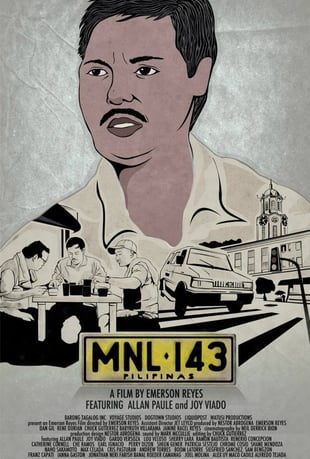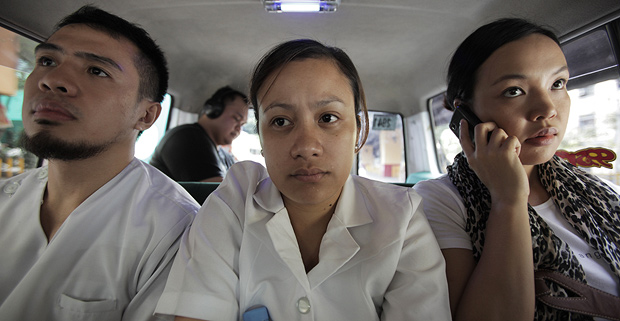
MNL 143 is a 2012 independent film directed by Emerson Reyes. This film features Allan Paule as Ramil and Joy Viado. Ramil is an FX (Tamaraw FX) driver plying the route of Quiapo-Fairview. He has been searching for his lover in Metro Manila for more than a few years. The film revolves around his last trip in the country as he will make it to Saudi Arabia the following day. As the trip goes along, different types of passenger from all walks of life come and go his FX. Each one of them leave the vehicle and Ramil had to watch them all slam the door and left.
Despite controversies in relation to the film being disqualified as a contender for the Cinemalaya film festival, MNL 143 participated in the Edinburgh International Film Festival.
MNL 143 is not just successful on bringing a new story and a new color to Philippine cinema. The movie goes beyond the usual script and directing as guga part of the film bring geographical characteristics to the audience. The film has shown the present urbanscape of Metro Manila and developed a topological map of Ramil’s journey in finding his lover; it has exposed the public transport system of Metro Manila with the presence of paratransit like other developing countries and explored the political geography of public spaces and spaces inside public transport vehicles; lastly, the film mapped Metro Manila by looking at the different demography, status and emotions of the passenger of the FX. As Ramil finds his lover, the geographic characters unfold throughout the movie.
MNL
An FX barker yelling out, ‘Fairview! Fairview!’, the crowded sidewalks wherein people walked past each other always in a hurry; the smoke coming out from the vehicles in the street and noise from at least almost every corner of the street; unrecognizable urban street pattern, small commercial stall around and huge billboards screaming the latest products from atop – this is the usual urban setting of Metro Manila on a regular day. The film established this landscape on the scene before passengers could fill up the FXof Rami. This landscape is the usual image of Metro Manila for an everyday commuter.
The film serves as a medium which depicts Metro Manila as a place in this form of media. Based on the article of Paul Adams, this place-in-media relationship gives the audience an idea of the landscape. This representation portrait the place as something tangible that audiences can feel. This image of the landscape also provides the audience the mood and the emotions included in this topic of urbanscape.

The urbanscape of Metro Manila was also explored more throughout the journey of the FX. The film provided a topological map of the route of Quiapo-Fairview going to the terminal and finding his girl. The trip starts at Quiapo then several stops are made at different locations to fetch and/or drop passengers. These locations are based o the real-life places which made it easy for the audience to recognize. The trip progresses on his usual route but the movie also depicts a progression map of Ramil’s emotions. As he is going farther, his face and actions serve as a map in knowing the status of his emotions. As he progresses in his journey, he is close to giving up on finding his lover. However, this particular ‘topological’ map on his face took a U-turn as his emotions also turn around when he saw his lover in the end.
FX
Majority of the scenes are shoot inside the vehicle Ramil is driving. Of al the modes of transportation in the Philippines, the film chooses the mode of FX. FX, a public transport mode in the country, carries passengers within major points of the city but there are also inter-urban and provincial operations. FX is one form of paratransit in the country. Most developing countries have almost the same paratransit mode. The presence of paratransit is said to have emerge from the inadequate or lack of mass transportation system a city or a country provides. This choice to show the industry of FX in the country somewhat depicts the inefficient transport system that our country is experiencing.
Other road films such as On the Road (2010) and Into the Wild (2007) provide a different transport mode in their films. Both films being set and produced in the United States embody the car-oriented culture of the west. Unlike the public transport road film MNL 143, On the Road and Into the Wild provide a private transportation of the characters for leisure and adventure.

Looking inside the FX, political geographies of space and territoriality are also shown in the film. Every one of us has our own personal space’s imaginary ‘bubble’. This bubble sometimes determine our emotions specially when we feel like we are being intruded. Private space in mass transportation grew thinner unlike when we are in our house or in our room. In the movie, passengers sit very close to each other and some people reacted to the uneasy feeling of being violated of their right to maintain their personal space.
The political geography of spaces inside the FX extends with the positionality, territoriality and seating arrangement of passengers. There is a seat beside the driver, seats in the middle and seats through the back door. These seats might be of different comfort or level but the film completely show that all is fair inside the FX. Whatever the job you are in, wherever you live or whoever you are, every one is paying the same rate and is being treated the same way despite the place where one is seated.
143 and beyond
Throughout the film, may people come and go. People of different backgrounds, interests and various stories. The film shows the different personalities and situations of the people in the urban landscape of Metro Manila.

The landscape of Metro Manila is very distinct from the landscape of other cities in the country or in the world. The film mapped out the different component of this landscape by showing the different experiences of the people of Metro Manila. People who ride the FX ranges from those rich to those less privilege people. Manila is known to have a wide range of people from different income classes, it houses both those well-off people and the poor ones.
The social character of the people also reflect the character of their city. The demography of the population are well-represented in the film MNL 143. There is this catholic devotee which curses out words and gossips. A mother who thinks he losses her son. A helper. Also, internet-savvy young people did not missed the scene. Then there is Ramil, a driver and an OFW. The film discusses themes in relation to Filipino religion, family structures, the young generation and the Filipinos seeking jobs and opportunities in other countries because they cannot find them here.
From the title of the film, MNL represents what is Manila. The film inspect the physical, social and cultural landscape of Metro Manila. This media serve as way in reflecting the country’s current situation specially in transport and development. Lastly, the film also mapped out Metro Manila based on the passengers emotions and characters on the FX. From the start of the trip to finish, MNL 143 delivers what is Metro Manila based on the director’s and writer’s perception in the hope of bringing awareness to the audience on what is happening to the city and the whole country.
Reference:
Adams, P (2010). A taxonomy for communication geography. Progress in Human Geography,35(1), pp. 37-57
Image Credits:
Feature image: Vimeo. https://i.vimeocdn.com//video/485656287_640.jpg
Vimeo. http://www.i.vimeocdn.com/vod_poster/24473_310x459.jpg
backtothefryingpan.wordpress.com/2013/01/mnl-143.jpg?w=1000
Front Row Reviews. http://www.frontrowreviews.co.uk/wordpress/wp-content/uploads/2012/07/MNLfeature.jpg
41.medi.tumblr.com/tumblr_m6rqwc7jFE1qax3ido2_1280.png


Hi Kenny G!
I like that this is the movie that you chose to analyze since I had the chance to watch this when I was on my freshman year. Actually when I was watching this movie, I was waiting for something surprising to happen. I then thought that there is nothing special in this movie, rather it is boring. Yet after I watched the film and during the open forum, I came into a realization that a story should not be extravagant and unusual in order for it to be movie-worthy. It can just be about showcasing everyday life. Just like this MNL 143, it may be plain and simple but it is a powerful tool to show what Manila is like especially for an outsider.
LikeLike
Your choice of movie interests me as it mainly explores local urban landscapes with the social and geopolitical aspects associated to them including transport and demography. By being well-documented in explaining the details of the movie, you have presented the different visual images of Metro Manila sufficiently through the scenarios inside a public FX. These basically represent what the reality of what Manila is, including its people and their whereabouts in a daily basis. This city, as what you’ve mentioned which I agree with, has a distinct landscape from other urban areas in the world and its people’s social character reflects that of the city. Places of everyday life are of high importance for us as these are the places where we do our daily activities and where people may form and create the places’ identity and character.
This is an intelligible and straightforward piece. Nice one, Kenny G.
LikeLike